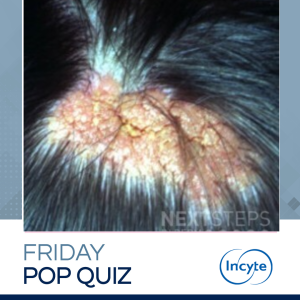
The correct answer is E. Trichoblastoma. Recognize the yellowish hairless plaque on the scalp most consistent with a nevus sebaceous. The most common secondary lesions to arise in these lesions are trichoblastoma and syringocystadenoma papilliferum, though other lesions may arise there as well.
Basal cell carcinoma, eccrine poroma, prurigo nodularis, and squamous cell carcinoma may arise in the location of a nevus sebaceous, but they are not the most likely lesions to do so.
References
Seo JK, Shin MK, Jeong KH, Lee MH. Eccrine Poroma Arising within Nevus Sebaceous. Ann Dermatol. 2020;32(6):516-518. doi:10.5021/ad.2020.32.6.516
